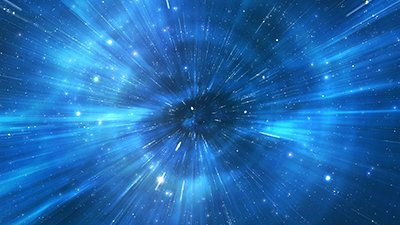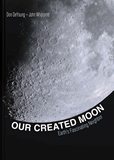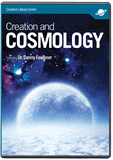
Astronomers Discover Clouds of “Primordial” Gas
Does pristine “primordial” gas prove the big bang happened?
News Source
Astrophysicists reported in the November 10 Science that they have finally found the first sample of space gas that fits big bang predictions. “The lack of metals tells us this gas is pristine,” graduate student Michele Fumagalli says. “It’s quite exciting, because it’s the first evidence that fully matches the composition of the primordial gas predicted by the Big Bang theory.”
Only hydrogen and its isotope deuterium were detected in two gas clouds examined using absorption spectroscopy. The clouds are located along a line-of-sight to a distant quasar. The spectrum is produced by the absorption of certain wavelengths of the quasar’s light. (Each element has a characteristic spectrum.) Professor J. Xavier Prochaska explains, “We don’t have any sensitivity to helium, but we would expect to see it if we did. We do have excellent sensitivity for carbon, oxygen, and silicon, and these elements are completely absent. . . . This is the first time we’ve observed pristine gas uncontaminated by heavier elements from stars.”1
Big bang cosmology holds that the only elements formed in the immediate aftermath of the big bang were hydrogen and helium (and trace amounts of lithium), other elements being formed later in stars. Yet astronomers have always detected other elements in the spectra from space. Astronomers refer to all elements heavier than helium as “metals.” Fumagalli explains that these findings reveal metals are distributed even more inhomogeneously in space than previously thought. “Metals are formed [within] stars and released into the universe,” she says, “but this process doesn’t occur the same way everywhere because we see these pockets that are left untouched.”2
Quasars are distant galaxies. Because some cosmologists believe distant light takes billions of years to reach earth, they interpret a telescopic look at a quasar as a peek backwards in time almost as far back as the big bang.
Secularists believe that these gas clouds correspond to a time about 2 billion years after the supposed big bang, based on the distance to the clouds as inferred from their redshifts. The environment surrounding these gas clouds has not yet been examined. “Using spectra, we can only probe the gas and its composition,” explains Fumagalli “We don’t know if it’s located close to a galaxy. What we’re planning to do is now study the environment of this gas to try to understand if it’s near a galaxy.”3
Even those who accept the idea of ancient age–big bang cosmology should not conclude they have their evidence when they find the right collection of elements in the wrong kind of place—a gas cloud instead of a star.
Thus, this discovery is being hailed as the discovery of gas 12 billion light years away and therefore gas that formed a “mere” 2 billion years after the big bang. This is also the first time that astronomers have detected gas that is apparently missing the heavier elements entirely. Big bang theorists have predicted that the first stars would be comprised of such zero-metallicity gas. However, no such stars have been found. It is surprising (from a big bang perspective) to find such gas in clouds that are allegedly billions of years younger than the first stars. Stars are supposed to create the heavier elements, and distribute them into the universe. So secular astronomers will now have to rethink their models of how and when metals are dispersed into intergalactic space. Perhaps these clouds are just a further example of that uneven distribution of elements in space. Even those who accept the idea of ancient age–big bang cosmology should not conclude they have their evidence when they find the right collection of elements in the wrong kind of place—a gas cloud instead of a star.
Furthermore, alternative explanations4 for light-travel time eliminate the idea that astronomers are peering back in time and instead demonstrate they are merely looking far away. Finally finding a couple of gas clouds with ultra-low metallicity, even though they are billions of light years away, does not prove the big bang happened. It just proves there is some hydrogen—as well as an expected amount of its isotope—out in space.
The big bang model not only disagrees with the Bible’s account of the origin of the universe (for the Scriptures teach the earth was made before the sun) but also has a number of other astrophysical problems.
Further Reading
- Get Answers: Astronomy
For More Information: Get Answers
Remember, if you see a news story that might merit some attention, let us know about it! (Note: if the story originates from the Associated Press, FOX News, MSNBC, the New York Times, or another major national media outlet, we will most likely have already heard about it.) And thanks to all of our readers who have submitted great news tips to us. If you didn’t catch all the latest News to Know, why not take a look to see what you’ve missed?
(Please note that links will take you directly to the source. Answers in Genesis is not responsible for content on the websites to which we refer. For more information, please see our Privacy Policy.)
Footnotes
- “Astronomers Find Clouds of Primordial Gas from the Early Universe, Just Moments after Big Bang,” Science Daily, November 11, 2011, https://www.sciencedaily.com/releases/2011/11/111110142050.htm.
- Denise Chow, “Primordial Gas Clouds Reveal Glimpse of Big Bang’s Aftermath,” Space, November 10, 2011, http://www.space.com/13570-big-bang-aftermath-primordial-gas.html.
- Ibid.
- See, for example, “Does Distant Starlight Prove the Universe Is Old?,” “Distant Starlight—The Anisotropic Synchrony Convention.”
Recommended Resources

Answers in Genesis is an apologetics ministry, dedicated to helping Christians defend their faith and proclaim the good news of Jesus Christ.
- Customer Service 800.778.3390
- © 2024 Answers in Genesis






